Math Day at I-STEM’s Multidisciplinary Summer Camp Adds Up to Fun
October 6, 2017
“Math should be painted in a fun light!” – Mathematics PhD student Vanessa Rivera-Quinones.
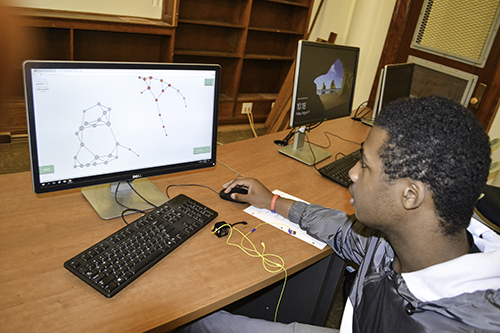
While playing VAX, UHS athlete Sergio McClain has successfully isolated the persons with the disease (the red dots) to stop the spread of the disease.
And that’s what the folks from Illinois’ math department did when 27 Urbana High School (UHS) athletes, mostly underrepresented minorities, participated in Math Day as part of the first-ever I-STEM Summer Camp. “This is math?” is a question that cropped up while, grinning from ear to ear, they raced against time to stop the spread of an epidemic on the VAX website, or wrestled with a challenging combinatorics activity, or struggled to get their mind around mathematical logic as Philip Hieronymi presented some virtually unsolvable brain teasers. So while participating in a variety of challenging, hands-on activities that showed them that math is useful in real-life situations and can be quite different from what they learn in school, they also learned to think outside the box where math is concerned and discovered that math can be fun.
Math Day on Friday, August 11, introduced the high schoolers to a number of Illinois’ mathematicians, who made the students feel welcome and introduced them to some of the work that they do. Mathematics Department Head, Matt Ando, welcomed the students and discussed the importance of math. Assistant Professor Phillip Hieronymi introduced students to mathematical logic via a “brain teaser” about Alan Turing. Plus, several math Ph.D. students, Elizabeth Field, Alexi Gorman, Vanessa Rivera-Quinones, and Colleen Robichaux led the high schoolers in hands-on activities related to math research.

Vanessa Rivera-Quinones, a math Ph.D. student, interacts with a UHS student
For instance, Vanessa Rivera-Quinones, a fifth year math Ph.D. student, uses mathematical models in her research to try to understand how disease spreads. In collaboraton with a researcher in bioengineering who studies specific parasites, she makes mathematical models to explain what happens during an epidemic in a lake ecosystem. To give students a glimpse into her work, she did a fun event with the students related to disease modeling, leading the students in an exciting exercise related to real life and to her work in epidemiology (the spread of infectious diseases).
In a website game, called VAX, students were to stop an infectious disease epidemic and were given a limited number of “quarantines” (breaking a link from one person to another) to try to stop the spread of the disease. However, once the disease got started, it spread rapidly from person to person, and the students were quite engaged as they scrambled to try stop it from spreading—with varying degrees of success.
For instance, how'd I-STEM mentor Kushal Goenka, an ECE major, do on the VAX game? He crashed and burned.
“The easy part was pretty simple, but the medium, I did quite bad. Everyone died in the game,” he confesses.
But despite the varying degrees of success the students—even the mentors—had, they had a great time. And Rivera-Quinones believes “math should be painted in a fun light,” and that’s why she participated in I-STEM’s camp. While admitting that math in school is interesting, she claims, “It doesn't tell you the complete picture. I always want try to motivate other students to see how math is used in non-traditional settings or how the math in high school could be pushed to explain some real-life phenomenon.”

Professor Phillip Hieronymi introduces students to mathematical logic
Regarding the impact I-STEM’s camp had on the students, Rivera-Quinones reports, “Since this program is trying to paint the picture of what a researcher looks like, hopefully they can see that it's not just one picture; across different disciplines, we do different types of things, and all of them are research.”
According to Rivera-Quinones, her main goal was for the students to gain confidence: “My hope for them is that they understand that there's not one definition of being a mathematician,” she explains. “They can also be mathematicians even though they're not pursuing a PhD in math. As long as they have interest in how things work and how patterns are formed, they can also be mathematicians.”

Elizabeth Field, a Math grad student, coaches a UHS student through an activity
She also hopes that the experience during the camp leads the students down the path of self-discovery and they gain some insight into how they might make their own unique contribution to the world.
“I think it's important that they're doing this program and that they get to see what it's like to be a scientist, or a mathematician, and really think about what that means for themselves…So I'm hoping this allows them to identify things about themselves and what they want to maybe pursue and hopefully, later on, contribute to the world.”
Elizabeth Field, another Math grad student, says she got involved with the camp because in high school, students don't really see how the math they’re learning is used. “They don't necessarily see that it's something they can actually study for a job. They see it more as a means to an end,” she says. "I think it's great for high schoolers to see that math and science are very different from what they're necessarily learning in high school. It's very cool for them to be able to see that it's something they can actually do or they're interested in.”
Regarding the impact the math day had on the students, Field adds, “I hope that it's allowed them to see that math can be used in ways that they haven't necessarily thought about. Who would think that you would use math to model how a disease spreads? You don't realize that.”
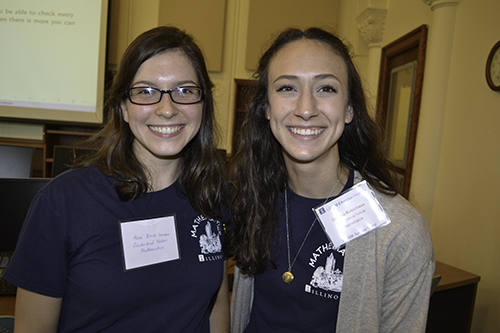
Math PhD students Colleen Robichaux and Alexi Gorman
Working with the combinatorics and number theory activity were Math PhD students Colleen Robichaux and Alexi Gorman. Combinatorics focuses on the patterns between various sets of numbers and evaluates similarities and differences between different sets of numbers. Students were taught about how numbers can be diagrammed to better see patterns between different numbers. Although the theory and way of thinking was new, as the students came to understand it, they found it interesting and enjoyable.
One instructor who worked with the combinatorics activity was second year Math PhD student Alexi Gorman, whose research is finding ways to make mathematical structures understandable in a way a computer might understand it.
Excited to work with high school students and high school athletes, she participated in Math Day because, “It's another good opportunity to make very sophisticated mathematics understandable to people who would benefit from knowing that this type of math is out there."
Colleen Robichaux, a second-year math PhD student interested in Algebraic Combinatorics says she participated in Math Day because she’s passionate about education. She says her undergraduate degree was math with a concentration in secondary education. “So I'm passionate about education and enjoy working with students. I was excited to show them concepts they had never seen before in a digestible way.”
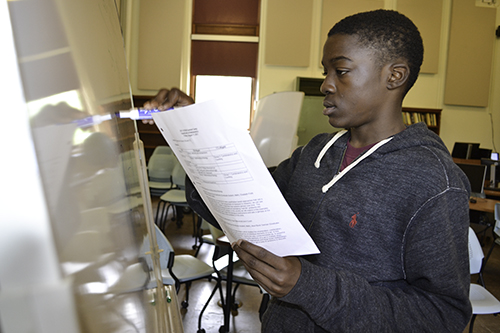
A UHS student works through a problem
Robichaux says it’s important to bring high school students onto campus for an event like the I-STEM camp’s Math Day so they might see math as a potential career. “If not for this program, many of these students would never have any idea of what math research is or that there is a place for them in math research. This program is excellent in that it not only humanizes the researchers, but also is designed to appeal to students to show them potential career paths they might never have considered. Further, it is simply a fun way to get students thinking!”
And according to Robichaux, the students learned that math is fun…and cool…and that they could do it!
“The students seemed very engaged,” Robichaux reports, “and surprised that what we were doing is considered math. They seemed intrigued and had fun thinking through the activity and discussing with their peers. In the long term, I think this has shown students a more realistic view of what mathematicians do and how we work, as well as showing them that they are more than capable of doing some cool math.
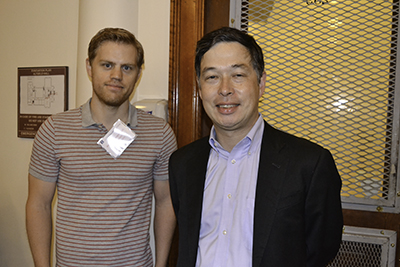
Professor Phillip Hieronymi and Mathematics Department Head, Matt Ando
Author/Photographer: Elizabeth Innes, Communications Specialist, I-STEM Education Initiative
More: 8-12 Outreach, I-STEM Initiatives, Math, STEM Pipeline, Summer Camp, Underserved Students/Minorities in STEM, Urbana High School, 2017
For additional articles about I-STEM's 2017 Summer Camp, see:
- I-STEM Multidisciplinary Summer Program Exposes UHS Athletes to Different STEM Departments/Units
- MCBees Use “Whodunit?” to Pique UHS Students’ Interest in Science During I-STEM Summer Camp
- MNTL Day Exposes UHS Students to Nanotechnology Research During I-STEM’s Summer Multidisciplinary Camp
- Akono and Company Teach UHS Students About Civil Engineering and Strength of Materials During I-STEM’s Multidisciplinary Summer Camp
- ECE Day at I-STEM’s Multidisciplinary Summer Camp: Soldering, Circuits, and Software
- During I-STEM Summer Camp, Urbana High School Students’ Understanding of Aerospace Engineering Soars
- UHS Students Explore Computer Science, Coding, During I-STEM Camp’s CS Day
- At I-STEM's Multidisciplinary Summer Camp, UHS Students Have Fun with Chemistry—Everything From Soap Making To Glow Sticks to Ice Cream
- UHS Students Gear Up for Mechanical Science and Engineering During I-STEM Summer Camp
- During I-STEM Camp’s NCSA Day, UHS Students Experience Data Visualization, Super Computers, and NCSA’s Research
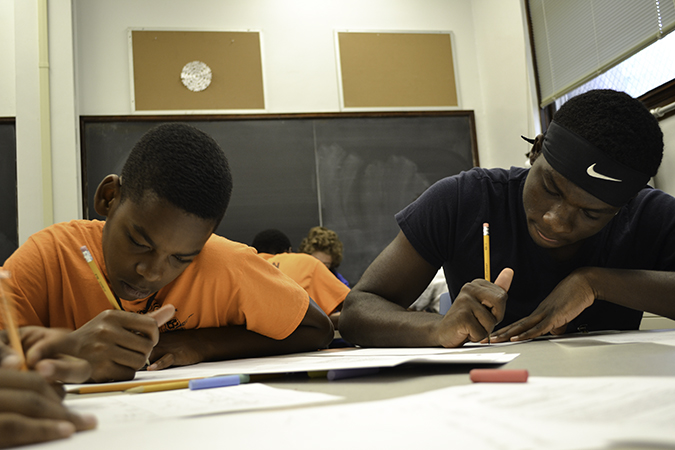
Two UHS students work through activities













.jpg)
















